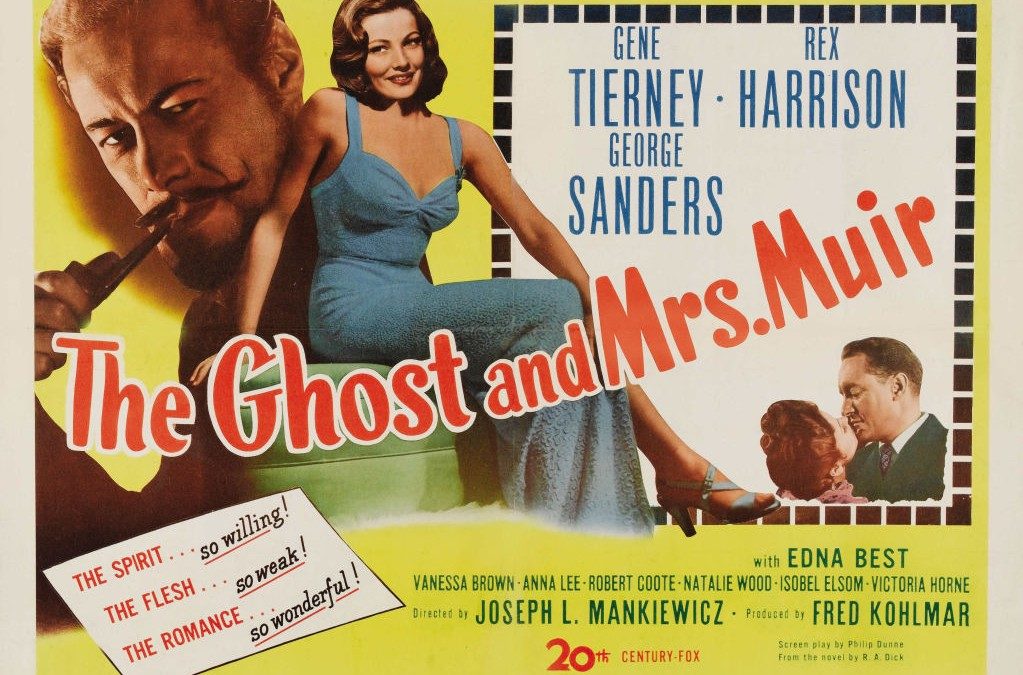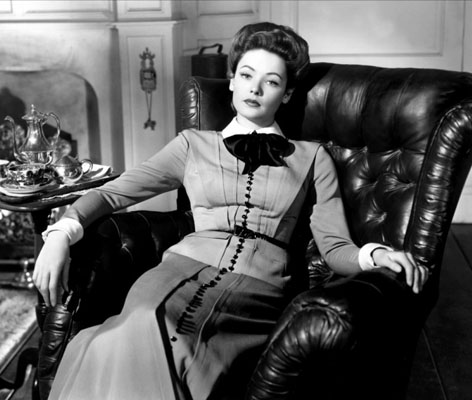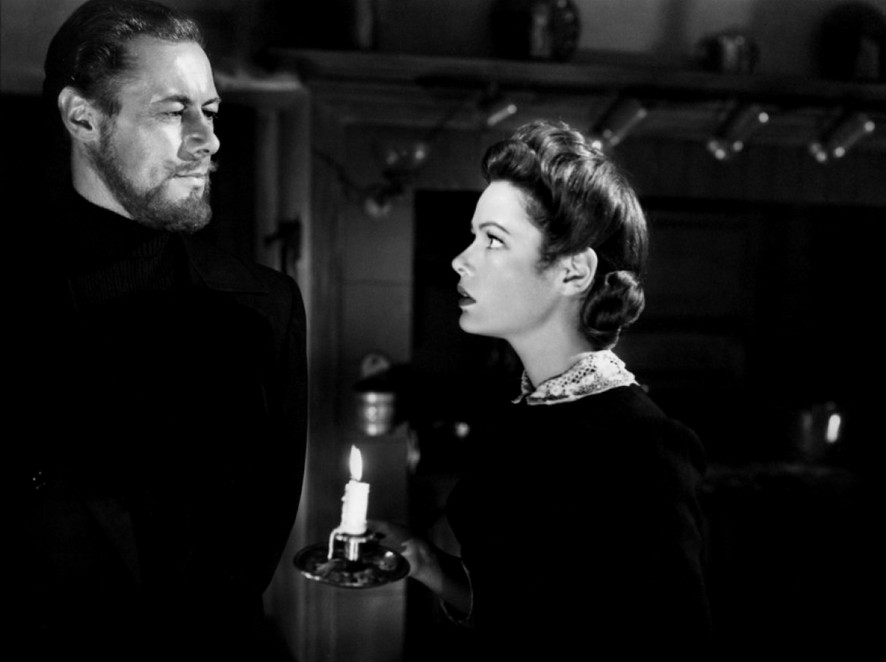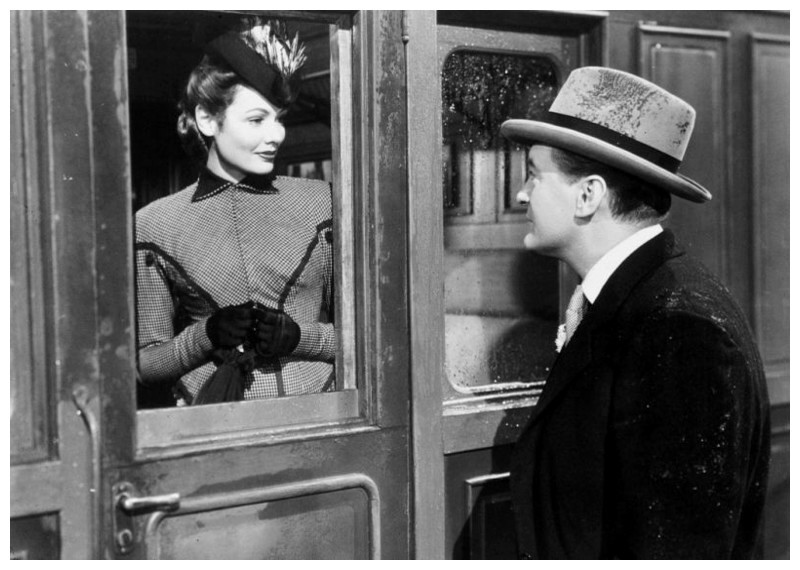??Where have you been all my life??
That?s how I feel when I see a movie for the first time and fall totally in love with it.?The Ghost and Mrs. Muir?was a movie I had certainly heard of, but I knew the title from the Hope Lange TV series of the same name in the mid-?60s, which hadn?t even captured my fancy when I was 8 or 9, and my disdain kept me from seeking out the movie.
Then a few years ago I started noticing raves about it, so the next time it was on TCM I gave it a tumble. And it?s been among my favorite movies ever since. When I signed up for this blogathon my list of movies I discovered via TCM was long, but I couldn?t resist a chance to write about?The Ghost and Mrs. Muir.
It?s a blend of genres?part haunted-house story (with few of the trappings and none of the horror), part comedy, split between ghost stuff and wonderful dialogue, part women?s picture, and part romance. A rather odd romance, with one partner alive and the other dead, but a real, mature, sexy, intimate, doomed romance.
Ghosts and haunted houses were big in the 1940s. It got to where you couldn?t swing a dead cat without smacking a ghost in movies like?It?s a Wonderful Life,?Here Comes Mr. Jordan, The Canterville Ghost, Portrait of Jennie, The Ghost Goes West, Hold that Ghost!,?I Married a Witch,?and?The Ghostbreakers. There had been ghosts before (Topper?and its offspring in the ?30s, for example), but whether it was somehow related to the war or just a morbid fancy, ghosts were definitely trending. These films all had different ideas about ghosts and the rules of ghostdom.
The Ghost and Mrs. Muir?is one of those perfect examples of the studio system at its very best. The movie is made up of so many elements, large and small, obvious or more subtle, that all contribute to the whole. The stars, script, direction, score, cinematography, costumes, editing, even that much-maligned figure, the producer?each played a role in making the film not just enjoyable but deeply satisfying.
Gull Cottage?the house Lucy Muir rents, the former dwelling of the late Captain Daniel Gregg?is one of the movie?s enduring charms. I want to live there. The house was built on the Palos Verde Peninsula in southern California. At the time the area resembled the English coastline of the early 20th century. Gull Cottage is now only a memory, and the hillside is filled with tract housing.
In this post we?ll look at some of those contributions to this grand collaborative effort.
Together their hard work, talent, and skill produced?an enduring movie, in this case over the protests of its esteemed director, who wanted to make a very different film.
Joseph L. Mankiewicz?had produced a lot of women?s pictures during his tenure at MGM, and he wasn?t interested in doing more of them now that he was under contract at 20th-Century Fox. His new contract was extraordinary: It gave him the choice of writing, directing, producing, one or all or in any combination he chose. But Darryl Zanuck still ran the studio, and Mankiewicz didn?t get his way about everything.
For example, Mankiewicz wanted Claudette Colbert to play Lucy Muir. He had known Colbert since they both worked at Paramount in the early ?30s under Mankiewicz?s idol Ernst Lubitsch (was any director ever more idolized by other directors than Lubitsch?). Mankiewicz felt Colbert would bring just the sort of knowing sexually mature quality he wanted for the part. But at Fox, the ladies under contract were always first in line for starring roles, and at the time Gene Tierney was a very big star. Mankiewicz disdained her and the other Fox model-turned-movie-star, Jeanne Crain, for their lack of training and dramatic range. But Tierney it was.
And?Gene?Tierney, whatever her acting limitations, is fine as Lucy Muir, poised between her exotic beauty and a down-to-earth?personality with a few romantic notions she mostly keeps tucked?away. Lucy is grounded and practical, but also a romantic who decides to live in a haunted house. Tierney?s otherworldly face is a wonderful counterpoint to Lucy?s briskness, and she?plays beautifully against Rex Harrison as the passionate, disembodied ghost of Captain Daniel Gregg. Tierney later said that despite Rex Harrison?s reputation as a bad boy, on this shoot he?was an absolute professional and a dream to work with.
By the late ?40s, Hollywood wasn?t giving us much in the way of independent women (outside of noir, and those dames?ll kill you). Postwar Hollywood represented women differently than they had even a few years before during the war, much less a decade and a half before that in Pre-Code movies. At that time Hollywood had offered audiences women who lived lives of glamour and adventure unlike anything 99.9 percent of the audience would ever experience. But screen representations of women in the ?40s were a horse of a different color, and the wised-up, resourceful women of the ?30s became either domesticated or noired up, splitting?into?bifurcation: impossibly?good (and often very dull) girls and really bad (frequently irresistible) girls.
Which makes Lucy Muir interesting. She?s unambiguously respectable, but she refuses to live in the confines of society?s expectations. She wants to live her own life, to do things, to be on her own. This is one of many reasons the movie still plays?it may be quaint in many ways (as it was when it was made), but Lucy?s determination to be her own person still speaks to us, just as Jo March?s does in?Little Women.
?A lusty sea captain who quotes Keats?now?this?is a female dream!? ?Jeanine Basinger
Rex Harrison?was perfectly cast as Captain Gregg, Lucy?s romantic apparition.
As Jeanine Basinger says on the DVD commentary: ?Here he is?handsome, sardonic, masculine, distinctive, a great mix of curmudgeonly comedy, sex appeal, and danger?.Sophistication is his thing, brittle strength, but always sex appeal?.?And he?s perfect for the role for that reason.? Harrison had begun his film career in England in 1930, but it was the two movies he made with Mankiewicz, this one and?Anna and the King of Siam, that made him a huge star and a sex symbol here in the U.S. He brings grace and a light touch to the part of Captain Gregg, who could have sunk in bombast. Harrison hits exactly the right register.
Ghost meets girl: Their first scene together and the only it-was-a-dark-and-stormy-night scene. The kitchen is dark, and both of them are in black, leaving visible only their heads, ?establishing that their romance will be disembodied, a relationship of spirits.
He growls and curses, but then a keen glance, a moment quoting poetry or watching Lucy, or just sitting with his arms crossed in that black turtleneck, and he reveals the soul behind the captain?s mannerisms. He gives the character dimension, and it makes what could have been a silly movie moving and emotionally true. Watching him fall in love with Lucy, which is conveyed very economically in just three fairly short scenes, is a delight. His original scowl softens, he looks at her with restrained tenderness and his pleasure in her company is clear. He is a worldly man falling in love, perhaps for the first time. Daniel Gregg went to sea when he was still a boy, and he kept on the move all his life. It was a grand adventure, and he had plenty of women, but I think he was moving too fast to ever really be captivated by any one of them. Death has slowed him down a little, and it is one of the movie?s ironies that now that he?s finally receptive to the joys of connection, he has no body with which to express his passion.
One of the paradoxes of ghost movies is that the actor portraying the apparition must have extraordinary presence. Basinger notes that ?It?s a brilliant presentation. He wears only one costume in the entire film: black. Black turtleneck, long black coat, and a striking silver belt buckle that will catch the light from time to time.? Mankiewicz?s biographer Timothy Geist says that putting Harrison all in black meant that only his head was lit, which made him incorporeal?that was the decision (presumably a joint one between the director and costumer) on making him ghostlike without any trick shots (there is only one in the whole movie).
Mankiewicz borrowed cinematographer?Charles Lang?from Paramount for this movie. Lang photographed some 150 feature films including?The Big Heat,?Some Like It Hot,?and?Gunfight at the OK Corral.?Each studio had its own photographic style, and Lang had 20 years??experience at Paramount style, which was quite different from the style at Fox. Paramount films were not as dramatically high-contrast as Fox?s. But Lang was able to make the stylistic shift seamlessly, and he photographed?TGAMM?with rich blacks and an opulent look.
Basinger: ?Details are everywhere. Nothing has been left out to make this a rich image, totally tactile and real for the audience?. Lang was one of only three DPs nominated for black and white photography in 1947, but he lost to Guy Green for?Great Expectations.?He was nominated 18 times for Oscars, winning only once in 1934 for?A Farewell to Arms.?His style is associated largely with deeply romantic black and white movies and the use of translucent light?. He could work, however, in any sort of genre, which was true of most of the great, top Hollywood cinematographers. But whatever movie [Lang]?was assigned, he lifted it above its genre and its script, giving it its own unique look, and providing a complexity of presentation. This film is visually beautiful, and the lighting of Charles Lang is as much a part of the story as anything else.?
Greg Kimble says in his DVD commentary: ?Notice that even when a shot is during the day, there?s always something in the room that?s lit from the floor as though it were night time. In the same way that you would hold a flashlight under your chin when you go trick or treating to give that ghoulish lighting, the film uses that in a very refined stylish way to imply the world of the ghost and his presence.?
I love this kind of stuff?I would never notice it on my own, but it contributes enormously to the overall emotional saturation and intensity of the movie. Each artisan adding their bit?Lang?s lighting, Herrmann?s hints in sound, to make us feel the unseen presence of the ghost without resorting to hokum. Very sophisticated, very subtle. But there?s a collective effect that prepares us for the ghost, makes us a little anxious because we feel his presence without knowing what cues we are responding to.
He may not be real, but it?s obvious that they do love each other. Given the ephemeral qualities of real-life romance, is this really that much flimsier than ?the real thing?? Are bodies what make it real?
In addition to the chemistry between Harrison and Tierney, their relationship is itself swoonworthy because Captain Gregg supports Lucy in her desire to be more than a proper lady, a shadow of her husband and family. He even gives her a new name, christening her ?Lucia,? a name for a goddess or an amazon, he says with relish. As Basinger points out, it is a real partnership, with each challenging and supporting the other. It is mature and respectful, but also silly and cantankerous. The spirit lovers hang around in the kitchen, in her bedroom, on the balcony?their relationship blossoms in domestic spaces, as if they are married. Captain Gregg is always encouraging her, reminding her that she is more than she seems to be.
She picks up his slang (?Blast!??a single code curse word to avoid setting off the censors). He quotes Keats. They look at the sea on the balcony and talk about the book they?re writing so she won?t have to go back to living with her appalling in-laws. She tells him how she came to marry her late husband after he kissed her in the woods when she had just read about a girl being kissed in a garden. And Gregg tells her about his life for their bestseller-to-be,?Blood and Swash,?his unvarnished memoir of life as a seamen.
It?s also intriguing and novel that the movie never gets pinned down about exactly what Gregg is?actual apparition, figment of her imagination, an imaginary?lover who sees her as what she yearns to be. I cannot imagine a movie today leaving itself wide open like this. People want everything spelled out and nailed down. They seem to think that if a thing isn?t actually said, it isn?t there. And yet Captain Gregg tells Lucy, ?I?m here because you believe I?m real.? Make of that what you will.
Real enough to make the censors nervous, however, so that Gregg finally reminds the audience ?I have no body? to reassure the audience that nothing untoward will happen when he watches Lucy undress or sleep.
Costumes for the production were designed by Fox?s costume department head?Charles LeMaire,with the exception of Tierney?s, which were designed, as all her costumes were in those years, by her husband?Oleg Cassini. He is best remembered for the iconic hat and coat he designed for Jackie Kennedy to wear to JFK?s Inauguration. Cassini?s costumes for Tierney in?The Ghost and Mrs. Muir?are an elegant mix of ??40s chic and period style. She looks gorgeously appropriate if not historically accurate, and the mix of periods is not at all intrusive. It was LeMaire who got the Academy to recognize the art of costuming with its own Oscar. LeMaire himself shared?Oscars with Edith Head for?All About Eve?and?Love Is a Many Splendored Thing.
Lucy?s corporeal boyfriend, Miles Fairley (George Sanders) turns out to be a lot less real than Captain Gregg
Screenwriter?Philip Dunne?was a New Yorker and a Harvard man who picked up his diploma and headed straight for Hollywood. He learned his trade at several?studios before taking up residence in 1937 at 20th-Century Fox, where he would remain for 25 years first as a writer, then later a director and producer. His best remembered works are?How Green Was My Valley?and?TGAMM. Dunne clashed with director Mankiewicz over the director?s approach to?TGAMM?Mankiewicz wanted to put a sophisticated spin on it, go for a Lubitsch tone to avoid what he feared would be an over-earnest romance, and Dunne was dismayed by where things were headed. He took his case to Zanuck, who agreed with him and ordered Mankiewicz to toss the first few day?s rushes and reshoot them without the twist. Would Mankiewicz?s approach have made it a better movie? We?ll never know, but Dunne?s idea still captivates audiences 68 years later.
I?m not at all persuaded that Mankiewicz was right about this one. His greatest strength was his facility with language. He wasn?t a particularly visual director, and he?s more cerebral than emotional. It?s interesting that he didn?t like this movie was still able to direct the actors so beautifully. I disagree with him, though, respectfully: It isn?t mawkish or leaden at all. It?s a little slow in the last third after Lucy takes up with cad Miles Fairley (the divine George Sanders), but critics agree that there was no way to solve that structural difficulty without making the movie 20 minutes shorter.
TGAMM?was cut by veteran editor?Dorothy Spencer, who worked at Fox from 1945 to 1979. She worked with John Ford (Spencer edited?Stagecoach?and?My Darling Clementine), Alfred Hitchcock, Ernst Lubitsch, and others in a career that spanned five decades. Spencer?was nominated for an Oscar four times but never won. She was a key figure in rethinking editing for widescreen format. Basinger says, ?She?s a perfect example of the excellent studio craftsperson. She used a classical style of editing?her goal was always that of story clarity, of the integrity of the mood of the scene, and directing the audience?s understanding toward both the meaning of the moment and whatever its emotional impact should be.?
TGAMM?was?Bernard Herrmann?s personal favorite of his film scores. It is also one of my favorites, and it is of central importance to the emotional tone of the film from the first strains of the theme, which we hear over the Fox logo (instead of the logo?s own instantly recognizable music). This was extremely rare, occurring only half a dozen times in all the years the logo was used. Says Chris Husted, the manager of the Herrmann estate: ?It was done with the aim of keeping the mood always in the foreground by plunging you into it immediately?. Herrmann?s attitude about film scoring always emphasized feeling and mood, because the mood in a film like this is part of what allows you to sink into a story about a ghost. He does this by letting small groups of instruments follow them around the house until they all gather around together and close in. The opening theme, says Husted, is itself the sea???endlessly turning, eternity into which Captain Gregg has already gone.?
Herrmann?s score is as central to the mood and character of the movie as it was in?Citizen Kane. Husted: ?What makes Herrmann?s style so different from composers of the time is that he would often write for small groups of instruments, and this partly comes from his experience in scoring radio dramas. That experience gave his film scoring a tremendous incisiveness, because it was very intimate. He was able to score for just a small group of instruments but make that group very expressive and atmospheric. He tends to orchestrate in ways that are juxtapositional, so you can identify certain groups within an orchestra very clearly when you listen to it. It?s not just this big wash of sound.
?Herrmann began work in January of 1947; filming finished in March. Sessions took place in one week in April, finished April 7. One extra session in May. Mankiewicz was delighted with it.
?This film seems to have a lot in common with English films of the same period. Herrmann was an unabashed Anglophile, and he was instantly and deeply drawn to Frederick Delius and other English composers. This film is situated right in the middle of the artistic scene he was drawn to. In England there was a much more liberal attitude toward film work for established composers.
??That?s what?s referred to as transparent orchestration? you can hear all the instruments: You can hear that oboe or the flute operating independently, rather than what you have with Max Steiner, where you get these big bludgeoning blasts of sound. That?s what distinguishes Herrmann?s style, and it?s true across his career. But in terms of harmony and melody this is an example of his earlier style. It?s more rooted in his concert music, where he?s more lyrically oriented?and is drawing his inspiration from French and English composers.
?There is an effect to evoke the ghost, a ringing. Herrmann has recorded a chord and cut the impact off so all you have is the resonance. David Raksin also did it. Herrmann did it in several films, prominently in?The Day the Earth Stood Still?seven years later. The idea is to have this impactless sound. In?TGAMM?it?s very important to give you the sense of the ghost being?somewhere.
?The sea music and this passage [just after Lucy tells the guy she wants the house] has two components: one, a bass movement that is very broad and conventional, and over it a very rapidly ascending figure that is a very elegant evocation of the shape of a wave in that a wave starts from the surface of the water, swells, and then in the center, breaks and spreads outward. Because the sea is always an ambiance, a location, an orientation that needs to be made in this film, because the sea is all around.
?The Ghost and Mrs. Muir?is a perfect kind of film for his mindset, and that?s why it?s well-known among his films. It captures his agenda in creating film music so well. The thing about?The Ghost and Mrs. Muir?is that it?s different in relation to the overwhelming, saturating experience you have now in watching films that are jam-packed with all sorts of isolated ideas. Here you have a story that is very carefully developed over a long course of time. There is a broader rhythm that is developed. There is an effort to create a mood that is sustained yet operates in much longer terms. Rather than just grabbing out hysterically in every direction, it follows a very concentrated path.
?And that was what Hollywood filmmaking was about for a long time, especially during the studio era. You were trying to link everything to the story, to bring everything into play so that it drove the story forward. That?s what?The Ghost and Mrs. Muir?is always seeking to do, visually and sonically. With Herrmann?s score you have a reliance on longer themes, which is a little unusual for Herrmann, but?you get a trend in the course of the film that is consistent. You have a sense of development. I think Herrmann was very anxious to craft something like this score, especially since he had been working on his most important concert work, his opera of?Wuthering Heights, and it was a very long-term project. But it had the kind of romantic abandon that he liked, and that he was trying to capture in his opera. So this was a way for him to tap into that mindset. This was more fanciful?and imaginative?in an unusual way.
?Herrmann?s life is often told in terms of being enmeshed with directors, particularly Hitchcock. But particularly in the ?50s, we know from letters that he viewed Hollywood as a way to make money to support his own composition. In Hollywood he was viewed as this highbrow from the East?
?The sea chanty grows out of the motive that identifies the house. The sea chanty is played by the clarinet in a low register. It starts to dissipate and be overtaken by the orchestra. Herrmann is careful to draw upon certain music when a certain part of the story has ended [the balcony scene when they have finished the book and have come to a dead end in their relationship].
?It makes references to a few seamen on a boat on the sea? so makes reference to when the captain had a corporeal body.
Even though?The Ghost and Mrs. Muir?is a fantasy, it?s an adult movie with adult problems, dealt with realistically. A relationship and kinship reaches an end despite the very real love?of the participants. And it was woven together in the extraordinary conditions of the studio system, with its vast resources and fantastic craftsman in every department right there waiting to be used. We mostly think that artists gets a rough deal from the studio (and often that?s true). But sometimes the system works. It worked beautifully for The Ghost and Mrs. Muir, and we?re all the beneficiaries.
This post was written for the TCM Discoveries Blogathon, highlighting movies we discovered via TCM and generously sponsored by?The Nitrate Diva.














One of my favorite movies